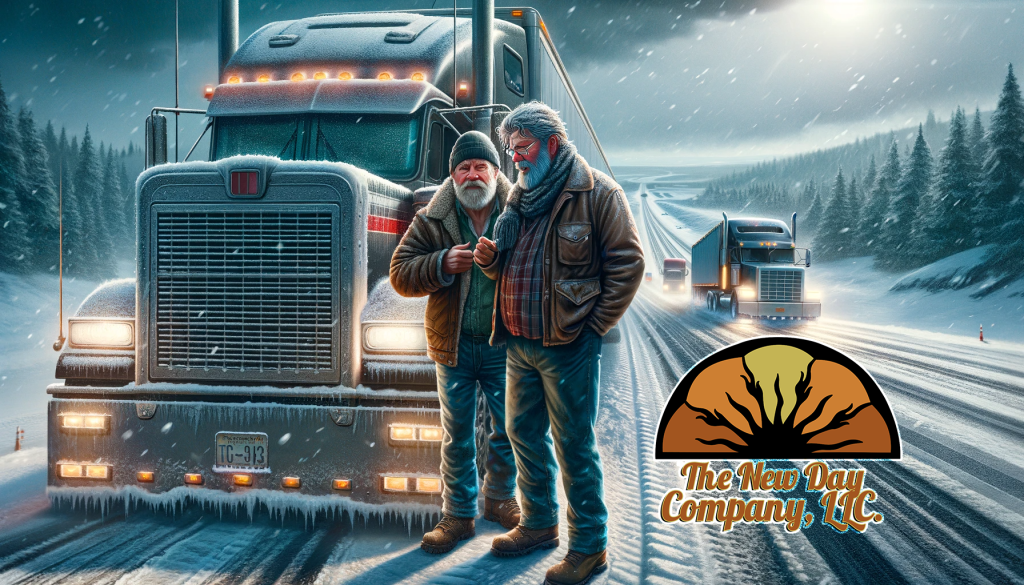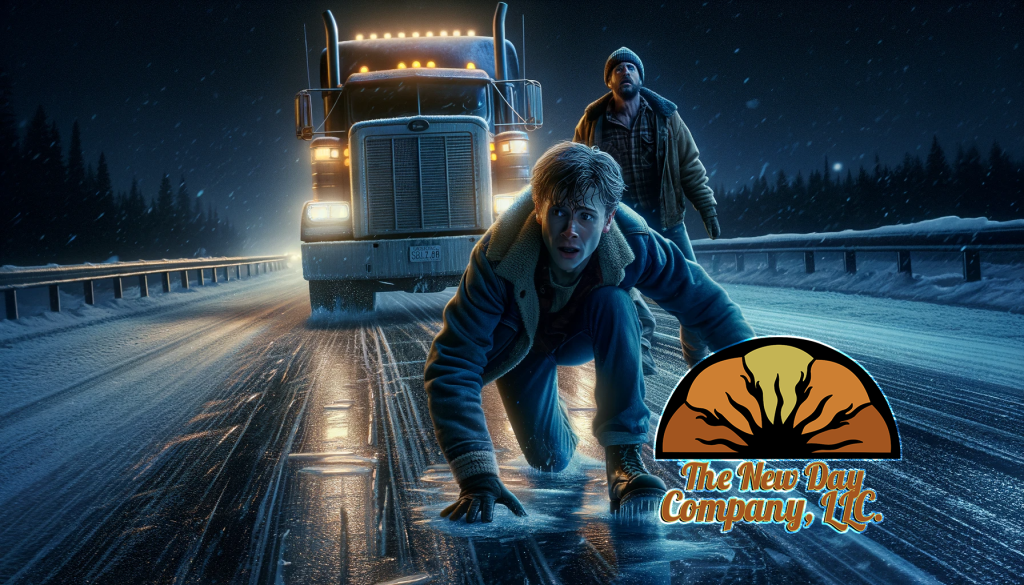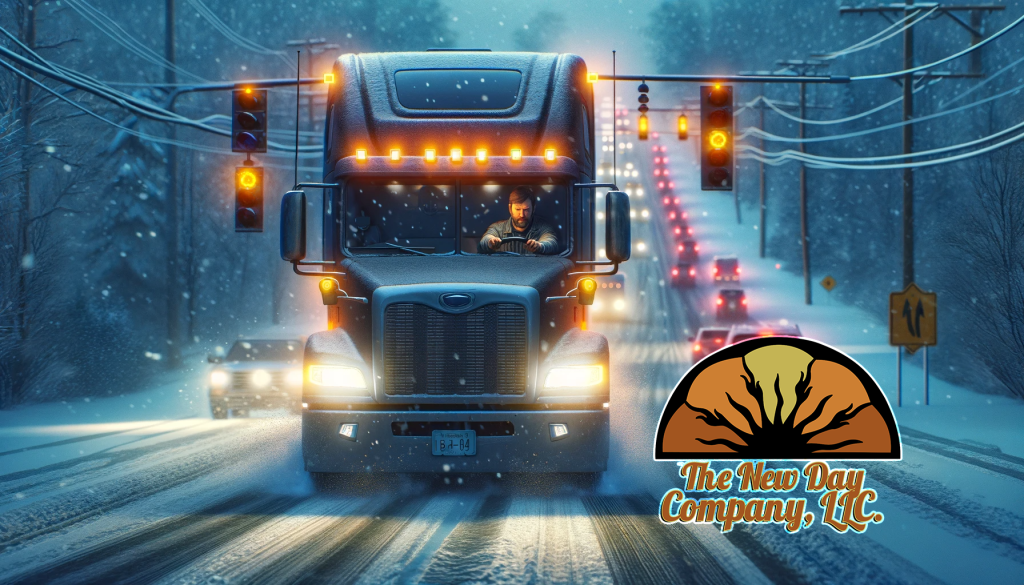Mastering Winter Roads: Veteran Trucker Sam’s, Guide to Safe Semi Driving

Winter driving for semi-truck drivers, especially those hauling trailers, is fraught with challenges. Sam, a seasoned trucker with over 30 years of experience, shares his hard-earned wisdom, focusing particularly on the dangers of black ice and fog.
The Perils of Black Ice and Fog
Sam, with the wisdom of a thirty-year veteran of the road, understands the perils of black ice and fog like few others. In his seasoned view, these conditions rank among the most treacherous a trucker can encounter. With a blend of earnestness and experience, he strongly advises his fellow drivers to prioritize safety above all else.
For Sam, the truck and its driver are the true ‘bacon’ — a term he uses with a twinkle in his eye, yet underscored by serious intent. In his philosophy, ‘bringing home the bacon’ isn’t just about completing a delivery; it’s about ensuring that both the truck and trucker return safely, ready to drive another day. This perspective places the well-being of the driver and the integrity of the vehicle above the urgency of any cargo they carry.
In Sam’s words, the load is important, but it pales in comparison to the invaluable ‘bacon’ — the life and livelihood represented by the driver and the truck. This analogy, born from years on the road, serves as a poignant reminder to all who navigate the unpredictable and often unforgiving highways: when faced with nature’s more formidable challenges, the wisest course is caution, even if it means pulling over and waiting out the storm. After all, the most precious cargo a truck carries is the driver themselves.
Identifying and Reacting to Black Ice
Drawing from his vast reservoir of road wisdom, Sam shares critical insights on confronting the stealthy menace of black ice. He knows all too well how this hazard can masquerade as a mere wet patch on the road, especially when the mercury dips below 34°F. His methodology in such situations is a blend of vigilance and practicality.
Sam’s first step is precautionary: slowing down and activating the hazard lights to alert fellow travelers. But his caution doesn’t stop there. He advocates for a hands-on approach when in doubt — stepping out and physically checking the road’s surface to confirm the presence of black ice.
Once black ice is identified, Sam’s strategy shifts to careful maneuvering. He recommends reducing the truck’s speed to a cautious 25-30 mph and downshifting to lower gears, preparing the vehicle to handle potential slippage. But Sam goes a step further with a unique tactic to gauge road traction. He suggests quickly increasing the engine’s RPMs, a move that tests the grip of the truck’s tires on the slippery surface. Watching for any wheel slip at these higher RPMs serves as a critical indicator of the road’s treachery. This technique, born from years of navigating risky terrains, offers a tangible measure to assess and adapt to the slippery challenge posed by black ice.
A Story of Caution
Sam recounts a particularly harrowing experience in Pennsylvania, involving black ice, a minivan accident, and the crucial role of CB radio in communicating dangers to fellow truckers. This story underscores the importance of being vigilant and ready to assist in emergencies.
A Trucker’s Tale of Caution: Black Ice on a Pennsylvania Road
Sam, a veteran trucker with over 30 years behind the wheel, recalls a harrowing night that encapsulates the dangers of black ice, a hazard he knows all too well.
It was a late evening in Pennsylvania, around 8 to 10 PM. Sam and another driver were cruising at 65 miles an hour on a fog-laden highway. The road, bathed in moonlight, appeared merely wet. On their CB radio, chatter crackled with routine banter until an urgent message broke through – a minivan had skidded and was now stuck under the trailer of a fellow trucker.

Alarmed, but steady, Sam and his companion decided to pull over to help. They chose a spot near the incident, where the traffic was sparse and seemingly safe. But the moment they stepped out, reality struck – they were standing on a sheet of black ice. The two truckers found themselves sliding uncontrollably. Sam, propelled by adrenaline, scrambled towards the median for safety, his heart pounding against the cold night air.
Reaching the median, Sam caught his breath and then made his way to the stranded minivan. Miraculously, the occupants were unharmed, though visibly shaken. Together, Sam and the other driver assisted the minivan off the road, ensuring everyone’s safety.
Following the rescue, they decided not to risk further travel. They drove to the nearest truck stop, where they spent the night, broadcasting warnings over the CB radio to fellow drivers about the treacherous black ice.
This experience served as a stark reminder for Sam: black ice is a formidable foe, one that demands respect and caution. It’s not just about navigating your truck through it; it’s about knowing when to stop and acknowledging that some risks aren’t worth taking. For truckers like Sam, the real victory isn’t just about delivering the load; it’s about understanding the road, respecting its dangers, and living to drive another day.
Navigating Wet Slush and Snow
In the throes of winter, semi-truck drivers like Sam confront a distinct set of challenges brought on by the combination of wet slush and snow. Sam emphasizes the critical nature of these conditions, particularly highlighting the dynamics of a semi-truck and its extended trailer. A key factor he points out is the considerable distance between the truck and the trailer, which significantly affects heat transfer to the axles. Unlike the truck itself, the trailer’s axles don’t benefit from the engine’s heat, making them more susceptible to the build-up of ice and snow unless proactive measures are taken.

Sam’s approach to managing this issue is meticulous and thoughtful. He recommends a specific technique involving the trailer brake. His method involves gently engaging the trailer’s brake system intermittently. This action, he explains, isn’t just about slowing down; it’s a deliberate tactic to generate enough friction and heat to keep the brakes clean, preventing the accumulation of ice and slush that could impede their function.
As the day progresses towards night, when temperatures typically drop further, Sam advises intensifying this braking process. This is particularly crucial in preparation for an overnight stop. He suggests a more robust engagement of the brakes during the last leg of the day’s journey. The goal here is to generate sufficient heat to dry out any moisture on the brakes, ensuring they don’t freeze overnight. This practice, born out of years of navigating wintry roads, underscores not just the need for safety but also the importance of understanding the unique mechanics of semi-trucks in cold weather conditions. For drivers like Sam, such knowledge and techniques are indispensable tools for ensuring safe and efficient journeys through winter’s demanding landscapes.
The Evolution of Technology in Trucking
Sam marvels at the advancements in trucking technology over the years, from improved snow removal techniques to automated driving systems in modern trucks. However, he prefers to rely on his own experience and judgment, especially after a few unsettling incidents with automated systems.
Navigating Winter Roads: Sam’s Essential Tips for Safety
Sam, drawing from his deep well of trucking experience, lays out a series of best practices for navigating the unpredictable and often treacherous winter roads:
Vigilant Observation and Dynamic Awareness
Sam underscores the importance of relentless vigilance while driving in winter conditions. He advises a constant, dynamic scanning of the road, advocating for a broad and active field of vision. This means regularly sweeping one’s gaze across the landscape, ensuring no fixation on a single point, and being ever-ready for sudden changes, such as unexpected merges or abrupt stops. This practice helps in anticipating and responding to potential hazards before they become critical.
Strategic Use of Hazard Lights and Controlled Deceleration

In situations where traffic slows or comes to a halt, Sam emphasizes the strategic use of hazard lights. This is not just about signaling your own deceleration; it’s about proactively alerting drivers behind you, giving them ample time to adjust their speed safely. By doing this, Sam believes truckers can significantly reduce the risk of accidents, especially on slippery winter roads where stopping distances are unpredictably long.
Efficient Fuel Management for Optimal Performance
With a particular note to smaller trucking companies, where resources may be more limited, Sam shares his insights on efficient fuel management. He suggests knowing and planning routes with the most cost-effective fuel stops. This involves not just looking at fuel prices but also understanding the truck’s fuel consumption patterns in cold conditions. Efficient fuel management, according to Sam, is a critical component of winter trucking, ensuring that the journey remains economical without compromising on safety or performance.
Through these practices, Sam conveys a philosophy of proactive and mindful trucking, where safety and efficiency coexist. These tips are not just rules to follow; they are insights shaped by years of facing winter’s wrath on the roads, making them invaluable for any trucker aiming to navigate these challenges successfully.

Wrappin’ It Up: Truckin’ with Heart and Smarts
Now, y’all, let me tell ya – Sam’s guide ain’t just your regular run-of-the-mill advice; it’s a downright tribute to the craft and savvy of truckin’. This fella’s been through it all, from skatin’ on black ice to keepin’ pace with all them newfangled gadgets they’re puttin’ in rigs these days. His stories ain’t just tales; they’re lessons hard-earned on the open road, as valuable to a greenhorn as they are to an old hand.
Sam wraps it all up with a dollop of country wisdom, infused with his seasoned ‘bring-home-the-bacon’ philosophy, and a crucial reminder about the importance of pre-trip checks. He’ll tell ya, driving a big rig is more than just a matter of steerin’ and gearin’. It’s about knowing every nook and cranny of your rig, just like the lines on your palm. It means giving those tires a good kick during pre-trip checks, ensuring everything’s shipshape before hitting the road.
Sam’s creed goes beyond the mechanics of trucking. It’s about tuning in to that gut feeling deep inside, staying ice-cool when the heat’s on, and always remembering that no haul is worth more than your well-being or the safety of your fellow road warriors.
In the world according to Sam, a true trucker strikes a fine balance between smarts and heart. It’s about keeping that big rig rolling smooth and steady, bringing home the bacon without burning the candle at both ends. ‘Cause when all’s said and done, trucking ain’t just about the journey from A to B. It’s about doing it with a touch of class, a heap of respect for the asphalt beneath, and, above all, making sure you always, always make it back to your doorstep safe and sound. Don’t ever skip those pre-trips; they’re what keep you looking good, kicking those tires, and rolling safe.
So, let’s tip our hats to Sam, a true maestro of the highways, who reminds us that truckin’, at its finest, is a dance of skill, guts, and wisdom, all rolled into one. Y’all drive safe now, ya hear?
